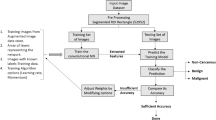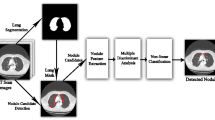Abstract
Lung cancer presents the highest cause of death among patients around the world, in addition of being one of the smallest survival rates after diagnosis. In this paper, we exploit a deep learning technique jointly with the genetic algorithm to classify lung nodules in whether malignant or benign, without computing the shape and texture features. The methodology was tested on computed tomography (CT) images from the Lung Image Database Consortium and Image Database Resource Initiative (LIDC-IDRI), with the best sensitivity of 94.66%, specificity of 95.14%, accuracy of 94.78% and area under the ROC curve of 0.949.










Similar content being viewed by others
References
Armato SG III, McLennan G, Bidaut L, McNitt-Gray MF, Meyer CR, Reeves AP, Zhao B, Aberle DR, Henschke CI, Hoffman EA et al (2011) The lung image database consortium (lidc) and image database resource initiative (idri): a completed reference database of lung nodules on ct scans. Med Phys 38(2):915–931
Boughrara H, Chtourou M, Amar CB, Chen L (2016) Facial expression recognition based on a mlp neural network using constructive training algorithm. Multimedia Tools and Applications 75(2):709–731
Chen H, Zhang J, Xu Y, Chen B, Zhang K (2012) Performance comparison of artificial neural network and logistic regression model for differentiating lung nodules on ct scans. Expert Syst Appl 39(13):11503–11509
Cheng JZ, Ni D, Chou YH, Qin J, Tiu CM, Chang YC, Huang CS, Shen D, Chen CM (2016) Computer-aided diagnosis with deep learning architecture: Applications to breast lesions in us images and pulmonary nodules in ct scans Scientific reports:6
Chollet F (2015) Keras. https://github.com/fchollet/keras
da Silva GLF, de Carvalho Filho AO, Silva AC, de Paiva AC, Gattass M (2016) Taxonomic indexes for differentiating malignancy of lung nodules on ct images. Research on Biomedical Engineering 32(3):263–272
Dandil E, Cakiroglu M, Eksi Z, Ozkan M, Kurt OK, Canan A (2014) Arti cial neural network-based classification system for lung nodules on computed tomography scans. In: Soft Computing and Pattern Recognition (SoCPaR), 2014 6th International Conference of, pp. 382–386. IEEE
de Carvalho Filho AO, de Sampaio WB, Silva AC, de Paiva AC, Nunes RA, Gattass M (2014) Automatic detection of solitary lung nodules using quality threshold clustering, genetic algorithm and diversity index. Artificial intelligence in medicine 60(3):165–177
Dolejs M (2007) Detection of pulmonary nodules from ct scans. Ph.D. thesis, Citeseer
Duda RO, Hart PE et al (1973) Pattern classification and scene analysis, vol 3. Wiley, New York
Eberhart RC, Kennedy J et al. (1995) A new optimizer using particle swarm theory. In: Proceedings of the sixth international symposium on micro machine and human science, vol. 1, pp. 39–43. New York
El-Baz A, Suri JS (2011) Lung imaging and computer aided diagnosis. CRC Press, Boca Raton
Elizabeth D, Nehemiah H, Raj CR, Kannan A (2012) Computer-aided diagnosis of lung cancer based on analysis of the significant slice of chest computed tomography image. IET Image Process 6(6):697–705
Gupta B, Tiwari S (2014) Lung cancer detection using curvelet transform and neural network. International Journal of Computer Applications 86(1)
Hansell DM, Bankier AA, MacMahon H, McLoud TC, Muller NL, Remy J (2008) Fleischner society: glossary of terms for thoracic imaging 1. Radiology 246(3):697–722
Hecht-Nielsen R (1989) Theory of the backpropagation neural network. In: Neural Networks, 1989. IJCNN., International Joint Conference on, pp. 593–605. IEEE
Holland JH (1975) Adaptation in natural and artificial systems: an introductory analysis with applications to biology, control, and artificial intelligence. U Michigan Press, Ann Arbor
Hong WK, Tsao AS (2007) Lung carcinoma: Tumots of the lungs. merck manual professional edition. Online
Hua KL, Hsu CH, Hidayati SC, Cheng WH, Chen YJ (2015) Computer-aided classification of lung nodules on computed tomography images via deep learning technique. OncoTargets and therapy 8:2015–2022
Huang PW, Lin PL, Lee CH, Kuo C (2013) A classification system of lung nodules in ct images based on fractional brownian motion model. In: System Science and Engineering (ICSSE), 2013 International Conference on, pp. 37–40. IEEE
INCA (2016) Instituto nacional do câncer, tipos de câncer: Pulmão http://www2.inca.gov.br/wps/wcm/connect/tiposdecancer/site/home/pulmao. Accessed: 29 July 2016
Kang K, Wang X (2014) Fully convolutional neural networks for crowd segmentation. arXiv preprint arXiv:1411.4464
Krewer H, Geiger B, Hall LO, Goldgof DB, Gu Y, Tockman M, Gillies RJ (2013) Effect of texture features in computer aided diagnosis of pulmonary nodules in low-dose computed tomography. In: Systems, Man, and Cybernetics (SMC), 2013 I.E. International Conference on, pp. 3887–3891. IEEE
Kumar D, Wong A, Clausi DA (2015) Lung nodule classification using deep features in ct images. In: Computer and Robot Vision (CRV), 2015 12th Conference on, pp. 133–138. IEEE
Kuruvilla J, Gunavathi K (2014) Lung cancer classification using neural networks for ct images. Comput Methods Prog Biomed 113(1):202–209
LeCun Y, Boser B, Denker JS, Henderson D, Howard RE, Hubbard W, Jackel LD (1989) Backpropagation applied to handwritten zip code recognition. Neural Comput 1(4):541–551
LeCun Y, Kavukcuoglu K, Farabet C et al (2010) Convolutional networks and applications in vision. ISCAS, In, pp 253–256
Lederlin M, Revel MP, Khalil A, Ferretti G, Milleron B, Laurent F (2013) Management strategy of pulmonary nodule in 2013. Diagnostic and interventional imaging 94(11):1081–1094
Leef JL, Klein JS (2002) The solitary pulmonary nodule. Radiol Clin N Am 40(1):123–143
Liu Y, Yin B, Yu J, Wang Z (2016) Image classification based on convolutional neural networks with cross-level strategy. Multimedia Tools and Applications 1–15
Nascimento LB, de Paiva AC, Silva AC (2012) Lung nodules classification in ct images using shannon and Simpson diversity indices and svm. Machine Learning and Data Mining in Pattern Recognition. Springer, In, pp 454–466
Ngo TA, Carneiro G (2015) Lung segmentation in chest radiographs using distance regularized level set and deep-structured learning and inference. In: Image Processing (ICIP), 2015 I.E. International Conference on, IEEE, pp. 2140–2143
Orozco HM, Villegas OOV, Dominguez HdJO, Sanchez VGC (2013) Lung nodule classi cation in ct thorax images using support vector machines. In: Artificial Intelligence (MICAI), 2013 12th Mexican International Conference on. IEEE, pp. 277–283
Otsu N (1975) A threshold selection method from gray-level histograms. Automatica 11(285–296):23–27
Parveen SS, Kavitha C (2014) Classification of lung cancer nodules using svm kernels. International Journal of Computer Applications 95(25)
Rubinstein RY, Kroese DP (2013) The cross-entropy method: a unified approach to combinatorial optimization. Monte-Carlo simulation and machine learning, Springer Science & Business Media
Schaer JD, Caruana RA, Eshelman LJ (1990) Using genetic search to exploit the emergent behavior of neural networks. Physica D: Nonlinear Phenomena 42(1–3):244–248
Sun T, Zhang R, Wang J, Li X, Guo X (2013) Computer-aided diagnosis for early-stage lung cancer based on longitudinal and balanced data. PLoS One 8(5):e63559
Sun W, Zheng B, Qian W (2016) Computer aided lung cancer diagnosis with deep learning algorithms. SPIE Medical Imaging. International Society for Optics and Photonics, In, pp 97850Z–97850Z
WHO (2012) Globocan 2012: World cancer statistics. http://globocan.iarc.fr/Pages/fact sheets cancer.aspx?cancer = lung. Accessed 04 Aug 2016
Wilson DR, Martinez TR (2001) The need for small learning rates on large problems. In: Neural Networks, 2001. Proceedings. IJCNN'01. International Joint Conference on, vol. 1. IEEE, pp. 115–119
Wu Z, Zhao K, Wu X, Lan X, Meng H (2015) Acoustic to articulatory mapping with deep neural network. Multimedia Tools and Applications 74(22):9889–9907
Zhang W, Li R, Deng H, Wang L, Lin W, Ji S, Shen D (2015) Deep convolutional neural networks for multi-modality isointense infant brain image segmentation. NeuroImage 108:214–224
Acknowledgements
The authors acknowledge CAPES and CNPq for their financial support. The authors acknowledge the National Cancer Institute and the Foundation for the National Institutes of Health for their critical role in the creation of the free, publicly available LIDC-IDRI database used in this research.
Author information
Authors and Affiliations
Corresponding author
Rights and permissions
About this article
Cite this article
da Silva, G.L.F., da Silva Neto, O.P., Silva, A.C. et al. Lung nodules diagnosis based on evolutionary convolutional neural network. Multimed Tools Appl 76, 19039–19055 (2017). https://doi.org/10.1007/s11042-017-4480-9
Received:
Revised:
Accepted:
Published:
Issue Date:
DOI: https://doi.org/10.1007/s11042-017-4480-9




